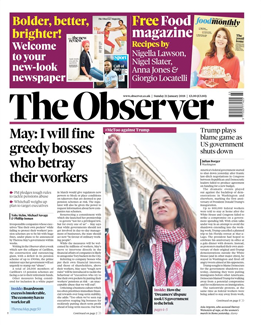The Observer (newspaper)

The Observer front page on 21 January 2018
|
|
| Type | Sunday newspaper |
|---|---|
| Format | Originally Broadsheet, Berliner (2006-2018) Tabloid (since 2018) |
| Owner(s) | Guardian Media Group |
| Editor | John Mulholland |
| Founded | 4 December 1791 |
| Political alignment | Centre-left |
| Language | English |
| Headquarters | Kings Place, 90 York Way, London |
| Circulation | 175,904 (as of March 2018) |
| Sister newspapers |
The Guardian, The Guardian Weekly |
| ISSN | 0029-7712 |
| OCLC number | 50230244 |
| Website | theguardian.com/observer |
| ISSN | 9976-1971 |
|---|---|
| OCLC number | 436604553 |
The Observer is a British newspaper published on Sundays. In the same place on the political spectrum as its sister papers The Guardian and The Guardian Weekly, whose parent company Guardian Media Group Limited acquired it in 1993, it takes a social liberal or social democratic line on most issues. First published in 1791, it is the world's oldest Sunday newspaper.
The first issue, published on 4 December 1791 by W.S. Bourne, was the world's first Sunday newspaper. Believing that the paper would be a means of wealth, Bourne instead soon found himself facing debts of nearly £1,600. Though early editions purported editorial independence, Bourne attempted to cut his losses and sell the title to the government. When this failed, Bourne's brother (a wealthy businessman) made an offer to the government, which also refused to buy the paper but agreed to subsidise it in return for influence over its editorial content. As a result, the paper soon took a strong line against radicals such as Thomas Paine, Francis Burdett and Joseph Priestley.
In 1807, the brothers decided to relinquish editorial control, naming Lewis Doxat as the new editor. Seven years later, the brothers sold The Observer to William Innell Clement, a newspaper proprietor who owned a number of publications. The paper continued to receive government subsidies during this period; in 1819, of the approximately 23,000 copies of the paper distributed weekly, approximately 10,000 were given away as "specimen copies", distributed by postmen who were paid to deliver them to "lawyers, doctors, and gentlemen of the town." Yet the paper began to demonstrate a more independent editorial stance, criticising the authorities' handling of the events surrounding the Peterloo Massacre and defying an 1820 court order against publishing details of the trial of the Cato Street Conspirators, who were alleged to have plotted to murder members of the Cabinet. The woodcut pictures published of the stable and hayloft where the conspirators were arrested reflected a new stage of illustrated journalism that the newspaper pioneered during this time.
...
Wikipedia
